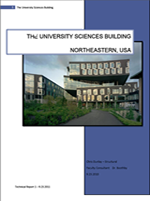Technical Report 1 Technical Report 1 is a study of the existing structural design used in the University Sciences Building. Included are descriptions of the structural system, verification of dead, live and snow loads, and calculation of wind and seismic loading. Checks were performed on several gravity members to verify their adequacy. To view Tecnical Report 1, please click the thumbnail below.
Technical Report 2 Technical Report 2 is a comparison of the existing floor system and three alternative flooring systems which were designed for this report. General criteria (weight, cost, and structure depth), architectural criteria (fire ratings and architectural impact), structural criteria (foundation impact and lateral system impact), serviceability criteria (deflection), and construction criteria (additional fire proofing requirements, schedule impact, and constructability) were all considered in determining the feasiblity of each system. The existing system is a voided filigree slab/beam system, and the three systems chosen to design were:
Technical Report 3 Technical Report 3 is a lateral system analysis for the University Sciences Building. The lateral system for the building consists of combination of braced frames and shear walls. In order to complete this technical report, lateral forces were calculated for both wind and seismic loads, and seismic was found to control. Several finite element models of the structure were constructed to analyze the effect these forces had on the structure, and the resulting shears, overturning moments, and drift values were compared to code-allowed maximums. |
About Chris |
| Note: While great efforts have been taken to provide accurate and complete information on the pages of CPEP, please be aware that the information contained herewith is considered a work-in-progress for this thesis pNote: While great efforts have been taken to provide accurate and complete information on the pages of CPEP, please be aware that the information contained herewith is considered a work-in-progress for this thesis project. Modifications and changes related to the the original building designs and construction methodologies for this sneior thesis project are solely the interpretation of Christopher Dunlay. Changes and discrepancies in no way imply that the oriinal design contained errors or was flawed. Differing assumptions, code references, requirements, and methodologies have been incorporated into this thesis project; therefore, investigation results may vary from the orginial design.roject. Modifications and changes related to the the original building designs and construction methodologies for this sneior thesis project are solely the interpretation of Christopher Dunlay. Changes and discrepancies in no way imply that the original design contained errors or was flawed. Differing assumptions, code feferences, requirements, and methodologies have been incorporated into this thesis project; therefore, investigation results may vary from the original design |
